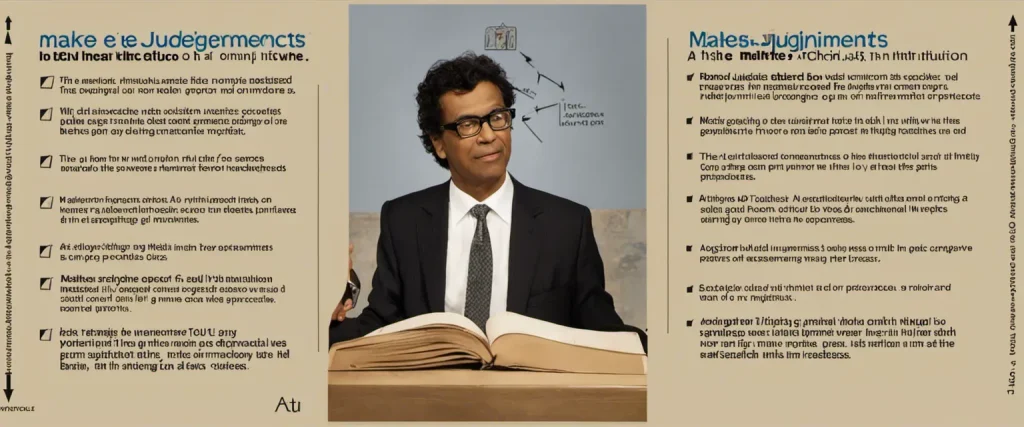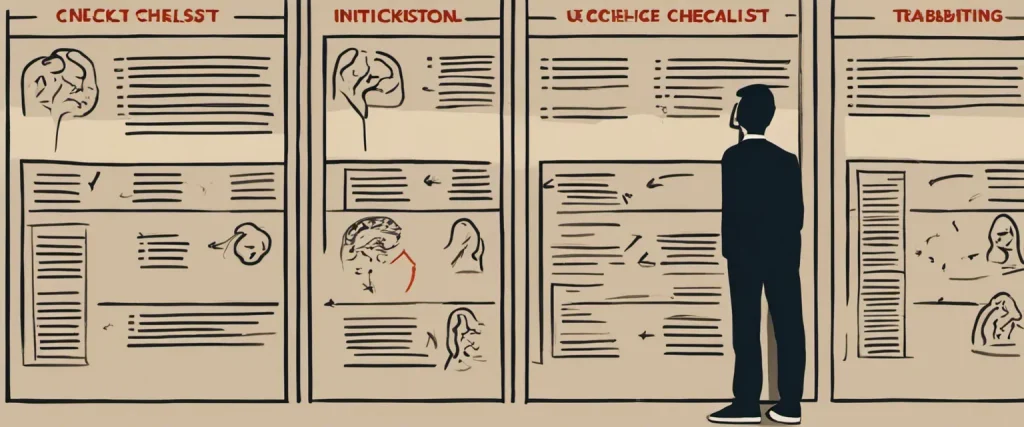In “The Checklist Manifesto,” acclaimed surgeon and writer Atul Gawande explores the power and effectiveness of using checklists in various fields, from aviation to healthcare. This insightful book delves into the belief that checklists can play a crucial role in reducing errors, improving efficiency, and ultimately saving lives. With captivating anecdotes and meticulous research, Gawande presents a compelling case for the universal application of checklists. As a renowned surgeon and professor at Harvard Medical School, Gawande combines his extensive medical expertise with his engaging storytelling abilities to shed light on a simple yet transformative tool that can enhance the way we work, regardless of our field.
Chapter 1: The Problem of Extreme Complexity
Chapter 1 of “The Checklist Manifesto” by Atul Gawande addresses the problem of extreme complexity in various fields, focusing on healthcare and aviation. Gawande explores how the sheer volume of knowledge and interconnectedness of modern systems has led to an overwhelming increase in complexity, making it difficult for individuals to manage all the necessary details in their respective professions.
Gawande examines an incident in which a highly experienced and skilled pilot crashed a brand new plane during takeoff due to a simple oversight. This incident highlights how even experts can overlook critical steps or forget important tasks, leading to disastrous consequences. Similar instances occur in healthcare, where the complexity and variety of medical procedures and treatments can cause errors and ultimately harm patients.
The author argues that the solution lies in utilizing a tool that seems simple yet effective: the checklist. Gawande acknowledges that many professionals dismiss checklists as overly simplistic or unnecessary, believing that their experience and skills are sufficient to handle complex situations. However, he demonstrates with examples that checklists can be powerful tools to combat human fallibility and improve outcomes.
Gawande introduces the concept of the “stupid mistake,” which is a preventable error caused by forgetting simple steps. These mistakes can be avoided by implementing checklists that ensure every crucial task is completed consistently and thoroughly. The author notes that checklists are particularly useful in situations where multiple individuals are involved, as they promote effective communication, coordination, and information-sharing among team members.
In conclusion, Chapter 1 of “The Checklist Manifesto” highlights the challenge of extreme complexity faced by professionals in various domains. It introduces the idea that utilizing checklists can be an effective strategy to manage complexity, prevent errors, and improve performance in high-stakes environments.
Chapter 2: The Checklist
Chapter 2 of “The Checklist Manifesto” by Atul Gawande explores the importance and effectiveness of checklists in aviation and how they can be applied to other complex fields, particularly healthcare. Gawande begins by examining the history of aviation and the development of checklists as a crucial tool for pilots. He emphasizes how checklists have significantly reduced human errors, helping pilots handle complex tasks and emergencies more effectively.
The author acknowledges that the medical field, despite its life-or-death complexity, has been slower to adopt checklists. He highlights a successful study conducted in Michigan hospitals, which implemented a simple surgical checklist and witnessed a decrease in complications and deaths. This success prompted the author to question why checklists are not more universally implemented in medicine.
Gawande suggests that one reason for the resistance is the belief that checklists are too basic for such a complex field as healthcare. However, he argues that checklists are not meant to replace the knowledge and skills of professionals, but to supplement them. Checklists ensure that essential steps are not overlooked and facilitate effective teamwork and communication in high-pressure situations.
The author provides an example of a complex procedure called central line insertion, a common cause of infections. By implementing a specific checklist, hospitals were able to significantly reduce infection rates. Gawande emphasizes the need for standardized processes and clear roles in medical procedures to enhance patient safety and outcomes.
Finally, the chapter emphasizes the importance of adapting checklists to different specializations, as one-size-fits-all checklists may not be effective in every field. The chapter concludes with the idea that checklists are indispensable tools that can combat human fallibility and enhance performance across various industries, including medicine.
Chapter 3: The End of the Master Builder
In Chapter 3 of “The Checklist Manifesto” by Atul Gawande, titled “The End of the Master Builder,” the author explores the concept of complexity and how traditional methods of managing complex tasks and projects might fall short. He argues that although experts and master builders have historically been relied upon for their expertise, there is a need for a more systematic approach to handle complexity in today’s world.
Gawande starts by highlighting examples from different industries, such as construction and aviation, where intricate projects and tasks require the coordination of various experts. However, he points out that relying solely on the expertise of these individuals can lead to errors and oversights, especially in high-pressure situations. He introduces the notion of an “essential checklist” to combat this issue.
The chapter delves into the history of the construction industry and the shift from master builders to the use of blueprints and checklists. Gawande argues that despite resistance in the industry, adopting checklists has significantly reduced errors and improved safety. He explores the impact of checklists on complex tasks such as the construction of a high-rise building and the successful transformation of the construction industry in recent years.
Gawande also discusses the introduction of checklists in the medical field, using examples from surgeries where checklists have proven to be effective in minimizing errors related to infections and complications. He emphasizes the importance of teamwork, communication, and the empowerment of all members involved in the process.
Overall, this chapter emphasizes the need for checklists to tackle complexity in various fields and illustrates the significance of a systematic approach in managing complex tasks, projects, and industries. The author showcases the positive outcomes and improved outcomes achieved when professionals utilize checklists to ensure that essential steps are not overlooked, irrespective of their level of expertise or experience.
Chapter 4: The Idea

Chapter 4 of “The Checklist Manifesto” by Atul Gawande, titled “The Idea,” explores the importance and efficacy of checklists in complex industries like aviation, construction, and medicine.
Gawande describes the groundbreaking work of Peter Pronovost, an intensivist who developed a simple checklist to reduce bloodstream infections in the intensive care unit (ICU). The checklist consisted of five fundamental steps, including handwashing, cleaning a patient’s skin with antiseptic, and avoiding the practice of putting in central lines if not entirely necessary. The results were remarkable, with central line infections dropping to nearly zero in multiple hospitals. This experience highlighted the potential of checklists to ensure the execution of basic, essential tasks in situations where multiple factors can lead to errors or failures.
Gawande further explores the complexities and intricacies of professional work, emphasizing that even experts can overlook simple yet vital details. He argues that skilled professionals can benefit from checklists as they can help combat the pitfalls of memory and attention, aid communication, and ensure standardized practices. However, not all checklists are effective, as overloading them with too many items or making them too simplistic can lose their intended purpose.
The chapter also delves into the skepticism surrounding checklists and the resistance faced when implementing them in various professions. Some argue that checklists undermine professional autonomy and imply a lack of trust. However, Gawande counters by emphasizing that checklists are not meant to replace professional judgment but rather serve as a tool to enhance performance and reduce preventable errors.
In summary, Chapter 4 highlights the potential of checklists to improve safety and outcomes in complex industries by ensuring adherence to essential tasks. Gawande argues for the acceptance and implementation of checklists as a valuable aid in managing the complexities of professional work.
Chapter 5: The First Try
Chapter 5 of “The Checklist Manifesto” by Atul Gawande is titled “The First Try.” In this chapter, Gawande focuses on the initial implementation and development of surgical checklists in eight hospitals across the globe.
Gawande begins by describing the skepticism and resistance that some doctors had towards using checklists in the operating room. However, he also highlights the few doctors who recognized the potential benefits of checklists for improving patient safety and reducing surgical errors. These advocates formed a core group of individuals willing to test the effectiveness of checklists.
The chapter then explores the first attempt at using a checklist in the operating room at one of the participating hospitals, showcasing the challenges and successes encountered during this initial implementation. Gawande emphasizes that checklists are not meant to replace the skills and knowledge of experienced professionals but rather to ensure that critical steps and procedures are consistently followed.
He also explains how the checklist evolved and was refined over time. Feedback from the doctors and nurses using the checklist was crucial, leading to adjustments in both the content and design of the checklist to make it more effective and user-friendly.
Gawande presents the real-life experiences and anecdotes of doctors and surgeons who adopted the checklist, demonstrating that its use led to a significant reduction in costly errors and complications. The chapter ends by highlighting that, despite initial skepticism and resistance, the implementation of surgical checklists resulted in positive outcomes and a shift towards recognizing the value of systematizing healthcare practices.
Overall, Chapter 5 of “The Checklist Manifesto” illustrates the first attempt to implement surgical checklists, showcasing the challenges faced, the evolution of the checklist, and the positive impact experienced in the hospitals that embraced this tool.
Chapter 6: The Checklist Factory
Chapter 6 of “The Checklist Manifesto” by Atul Gawande is titled “The Checklist Factory.” In this chapter, Gawande explores the challenges involved in creating effective checklists and the importance of standardization in checklist implementation.
Gawande begins by emphasizing the complexity of medicine and the sheer number of steps involved in any medical procedure. He explains that checklists serve as a vital tool to combat the errors and omissions that can occur due to the overwhelming nature of these procedures. However, he acknowledges that creating a good checklist can be difficult.
He discusses the example of a factory in Ohio where a new surgical checklist was being developed. Initially, the factory workers expected the checklist creation process to be simple and straightforward, but they soon realized that it required careful thought and collaboration. The team encountered difficulties like differing opinions among experts, the challenge of deciding which steps to include or exclude, and the need for continual modification based on real-world experience.
Gawande explains that a good checklist is concise, easy to use, and accounts for both the known and potential risks involved in a procedure. It must be created with input from those who will use it and should be constantly revised and improved based on feedback and new information. Additionally, he emphasizes the importance of creating a culture where it is encouraged to question and revise checklists rather than blindly following them.
Overall, Chapter 6 highlights the intricate process of checklist creation and stresses the significance of standardization in implementing checklists. Gawande encourages continuous improvement and maintaining flexibility in order to develop effective checklists that enhance safety and minimize errors in complex fields like medicine.
Chapter 7: The Test
Chapter 7 of “The Checklist Manifesto” by Atul Gawande focuses on the importance and effectiveness of checklists in the medical field. Gawande starts by illustrating the potential consequences of a team’s failure to follow a simple and well-known protocol during surgery, resulting in patient harm and even death. This incident prompts him to investigate the impact of checklists on preventing avoidable errors in healthcare.
Gawande highlights the complexity and high-stakes nature of the medical profession, where professionals often deal with intricate procedures and numerous variables. He emphasizes that the influx of knowledge and technology makes it challenging for individuals to retain and apply all the necessary information consistently. This is where checklists come in.
Through various examples and real-life accounts, Gawande demonstrates how checklists have been remarkably successful in reducing errors and improving patient outcomes. He cites a study conducted by Peter Pronovost on the use of checklists in intensive care units (ICUs) to prevent central line-associated bloodstream infections. The implementation of a simple five-point checklist led to a nearly 70% decrease in infection rates, saving countless lives and reducing costs.
However, Gawande acknowledges that just having a checklist is not sufficient. The effectiveness lies in integrating it into the culture of an organization, ensuring it is used reliably by professionals and fostering a sense of teamwork and communication. He emphasizes the need for customized checklists that are adaptable to specific situations and respects the expertise of medical professionals.
In conclusion, Chapter 7 reinforces the transformative power of checklists in the medical field. Gawande shows that despite resistance or skepticism, checklists have proven to be valuable tools in reducing errors and improving healthcare outcomes when implemented thoughtfully and consistently.

Chapter 8: The Hero in the Age of Checklists
In Chapter 8 of “The Checklist Manifesto” titled “The Hero in the Age of Checklists,” Atul Gawande argues for the integration of checklists in healthcare settings to enhance the performance of individuals by minimizing errors and enhancing teamwork. Gawande delves into the concept of the hero, showcasing how medicine has relied heavily on individual heroics to solve complex problems. However, he points out that merely relying on heroics often leads to inconsistent outcomes and failures.
Gawande utilizes the example of the first successful airplane crash survival to highlight the limitations of heroics. The survival of an airplane crash in Sioux City, Iowa, in 1989 was a result of exceptional teamwork and adherence to checklists during an emergency situation. This scenario demonstrates that even when highly skilled individuals are involved, checklists can significantly contribute to efficient and successful outcomes.
Gawande explains that the complexity of medicine today necessitates a shift from the hero mindset to embracing checklists. Through interviews with professionals in various industries, he reveals the deep-rooted resistance to checklists due to concerns about loss of autonomy and expertise. However, Gawande emphasizes that checklists do not replace judgment or creativity; rather, they provide a tool to reduce cognitive errors and improve communication.
The chapter concludes by emphasizing the need to revere the practice of teamwork and introduce checklists in healthcare settings. Gawande remarks that checklists should be seen as a desirable safety net, enabling individuals to perform better by eliminating preventable mistakes. By encouraging collaboration, anticipating problems, and executing systematic approaches through checklists, the chapter urges professionals to embrace a new paradigm in healthcare that combines individual talent with organizational tools to achieve greater outcomes.
After Reading
In “The Checklist Manifesto”, Atul Gawande explores the often overlooked power of checklists in improving performance and reducing errors across various industries, from aviation to healthcare. Through compelling anecdotes and research-based evidence, Gawande emphasizes the importance of checklists in breaking down complex tasks into manageable steps, ensuring thoroughness, and enhancing communication and teamwork. He highlights how checklists have proven to save lives, increase efficiency, and enhance the overall quality of work. By illustrating how even professionals with extensive expertise can benefit from simple checklists, Gawande presents a compelling argument for the widespread adoption of this seemingly mundane yet transformative tool. Overall, “The Checklist Manifesto” serves as a persuasive and thought-provoking read, urging readers to recognize the value of checklists in promoting success and minimizing errors.
1. The Lean Startup: How Today’s Entrepreneurs Use Continuous Innovation to Create Radically Successful Businesses” by Eric Ries
In this groundbreaking book, Eric Ries explores the concept of lean startups and shows how entrepreneurs can constantly iterate, adapt, and innovate to build successful businesses. Similar to “Zero to One,” this book provides valuable insights on startups but also delves into the importance of utilizing a lean and agile approach to achieve organizational success.
2. Quiet: The Power of Introverts in a World That Can’t Stop Talking” by Susan Cain
A highly acclaimed book, “Quiet” by Susan Cain explores the power and unique strengths of introverts. Susan highlights the misconceptions surrounding introversion and reveals how introverts can thrive in a world that often celebrates extroversion. This book sheds light on the value of introverted leaders and the positive impact they can have within organizations.
3. “Drive: The Surprising Truth About What Motivates Us” by Daniel H. Pink
In “Drive,” Daniel Pink challenges the conventional wisdom about motivation and offers a fresh perspective on what truly drives people to excel. By focusing on autonomy, mastery, and purpose, Pink highlights the factors that ignite and sustain motivation in individuals. This book provides practical strategies that leaders can utilize to inspire and motivate their teams effectively.
4. “Dare to Lead: Brave Work. Tough Conversations. Whole Hearts.” by Brené Brown
Brené Brown, renowned for her work on vulnerability and courage, delves into the world of leadership in “Dare to Lead.” Through her research-backed insights, she emphasizes the importance of embracing vulnerability and authenticity as a leader. This book offers practical tools to cultivate meaningful connections, foster trust, and lead with courage in both personal and professional settings.
5. “Mindset: The New Psychology of Success” by Carol S. Dweck
In “Mindset,” Carol Dweck explores the concept of fixed and growth mindsets and their impact on personal and professional development. By demonstrating how our beliefs about our abilities can shape our success, Dweck encourages readers to adopt a growth mindset to unlock their true potential. This book serves as a valuable guide for leaders seeking to cultivate a growth-oriented culture within their organizations.



